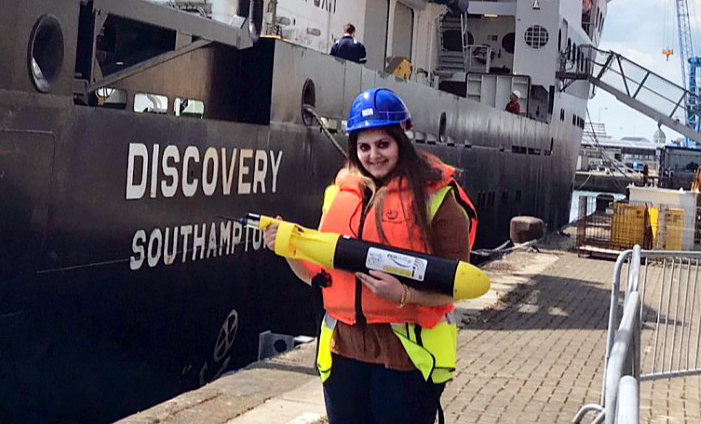
Unlocking new data on ocean greenhouse gas emissions
Researchers at the University of Southampton’s Optoelectronics Research Centre and the National Oceanography Centre Southampton (NOCS) are developing a new generation of smart, low-cost optical sensors capable of detecting greenhouse gases and pollutants in our oceans. The technology is set to revolutionise ocean monitoring techniques and will enable scientists to answer urgent questions about global warming processes for the first time.
Combining the power of photonics and nanotechnology, Dr Rand Ismaeel and her team are incorporating highly sensitive optical fibre isotope detectors into miniature autonomous underwater vehicles. They are working with Planet Ocean and NOCS to develop and test the technology as part of a five-year Royal Academy of Engineering Fellowship.
Understanding methane emissions
One objective of the research is to gain insights into the dynamics of ocean methane emissions, which are currently not well understood. To date, the planet’s oceans have acted as a buffer to mitigate climate change, absorbing around 23% of the annual emissions of human-made CO2 and more than 90% of the excess heat from human activities. However, the oceans themselves are also getting warmer. This could trigger the release of vast amounts of methane – itself a greenhouse gas – into the atmosphere, accelerating global warming with potentially catastrophic effects.
As Rand explains, there is an urgent need to understand the cycle of ocean methane emissions. “Some of the ocean’s methane comes from hydrates, which take the form of rocks in large quantities on the ocean floor. These hydrates destabilise as ocean temperatures rise, emitting methane bubbles. Other sources of methane emissions are caused by bacteria or other organisms. Until we develop a good understanding of the cycle of methane as well as its origin, we can’t understand the extent of the problem or look for ways to mitigate it.”
The sensors designed by Rand and her team will help to answer these questions by collecting previously unattainable data, shedding light on methane transformation at different depths and temperatures as well as emission patterns into the atmosphere.
Smarter, cleaner, more agile ocean monitoring
Current ocean sensing technologies can only detect hydrocarbons such as methane and CO2 using gas separation methods from seawater. This requires bulky, power-hungry equipment that has to be deployed from ships, making it very expensive. The team’s new sensors work without gas conversion and remove the need for a vessel to carry the equipment – the low-power autonomous vehicles can simply be dropped into the ocean and operated remotely to gather data at the desired location and depth.
“In previous decades this was something scientists could only dream of,” says Rand. “Photonics enables us to target specific molecules and gather instant data, while nanotechnology enables us to move away from big, bulky machines to lab-on-a-chip devices.”
Safeguarding the oceans’ ecosystems
The new technology will also help to safeguard the ocean environment through more effective undersea oil pipeline monitoring. As well as being very expensive, current methods tend to detect leaks only when the damage is already done, whereas the new sensors are much more sensitive, enabling leaks to be identified and repaired before they cause serious problems.
Rand adds: “What I’d like to see now is an extra push from the government and universities to pave the roadmap for these technologies, so that we can recruit more researchers to look at the environmental problems we are facing and fund the technologies to save our oceans.”